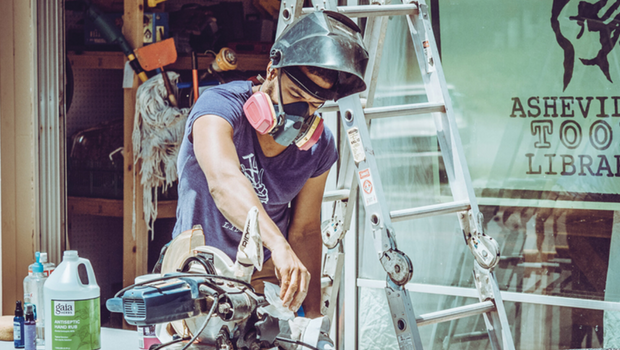Conscious Consumerism: The Rise of Sharing and Reselling
Tucked into the Blue Ridge Mountains of North Carolina, Asheville is a DIY kind of community, attracting artists, musicians, yoginis, homesteaders and other folks looking to live a simpler life. When they garden and undertake home repairs, Ashevillans find it easy to cut expenses: They’ve formed a collective tool shed, the Asheville Tool Library, which offers them the use of 2,000 donated tools ranging from safety goggles to leaf mulchers and circular saws.
“When you need a pressure washer once a year or decide to put in a garden, you don’t really need to own those tools,” says treasurer Stephanie Kane. People are allowed to take on projects they couldn’t otherwise afford, she says, “or they utilize existing skills to build the life they want, or even get a business off the ground.”
To combat inflation, which is squeezing family budgets, Americans are increasingly exploring shared resources and eco-friendly alternatives like thrift stores, flea markets and rummage sales. Often aided by online technology, local shared enterprises and secondhand shops are saving people money and reducing the impact of excess consumerism on the environment.
Neighborly Sharing
More than 50 tool-lending libraries exist in cities like Denver, Seattle, Atlanta and Washington, D.C., allowing people to “cut down on waste and overbuying, while helping out neighbors,” reports The Washington Post. Typically, they are staffed by volunteers and supported by nominal, income-based annual fees.
Starting a tool-lending library begins by connecting with other people in the community, using local online groups and co-op bulletin boards to attract volunteers and donations, or hosting a drive for people to clean out their basements, Kane says. As memberships grow, additional tools can be purchased and employees can be hired. Website design and inventory tracking in Asheville and elsewhere is simplified by the “library of things” software from myTurn.
Another way that people share resources is through Little Free Libraries—the charming “library on a stick” boxes on neighborhood posts and fences that give away books to passersby. It began in Hudson, Wisconsin, in 2009, when Todd Bol built a tiny model of a one-room schoolhouse as a tribute to his deceased mother, an educator and voracious reader. He stocked it with books and put it on a post in his front yard for neighbors and friends. The concept became so popular that he built more and gave them away. Today, more than 150,000 Little Free Libraries are found in communities worldwide.
Secondhand Thrifting
Whether housed in a local storefront or existing digitally online, resale shops have become big business due to pandemic-inspired decluttering and belt-tightening pursuits. Industry analysts expect thrift store clothing sales to grow globally 11 times faster than fast fashion and to be worth twice as much, at $84 billion, by 2030.
Buying secondhand benefits not only shoppers, but also local governments struggling with the expense of operating landfills. Hennepin County, Minnesota, which includes Minneapolis, has resolved to send zero waste to its landfills by 2030. Part of this effort includes the Choose to Reuse campaign, which encourages people to shop secondhand as a way to save money, help the environment, reduce packaging, support local businesses and find unique items.
Nonprofit thrift stores like Goodwill Industries and The Salvation Army or those run by longtime charities like the American Cancer Society and Society for the Prevention of Cruelty to Animals have well-established reputations and proven track records. Habitat for Humanity’s ReStore has more than 900 locations nationwide, offering an ever-changing stock of secondhand furniture, household items and building materials like doors, windows and lighting fixtures. On the other hand, for-profit thrift stores, even if they claim a link to a worthy cause, often donate a much smaller percentage of profits to charity and are reluctant to release financial figures, reports Salon.
Online Pluses and Minuses
An influx of online resellers adds even more choices for secondhand items. Although they make shopping more convenient, online sites carry risks: In 2019, the Federal Trade Commission reported more than 173,000 instances of online shopping fraud. When shopping online for secondhand items, experts advise, it’s wise to shop and pay on a trusted website or app, and to avoid using a personal debit card. Be sure there are photos of the product. On sites like Craigslist, eBay and Facebook, check each seller’s rating and thoroughly review all buyers’ comments before making a purchase.
With a little enterprise, savvy and flexibility, mass consumerism can be circumvented by sharing community resources and frequenting quality secondhand stores. As Kane puts it, “The sharing economy is essentially about leading a less consumerist lifestyle.”
Sheila Julson is a freelance writer and regular contributor to Natural Awakenings magazine.





























